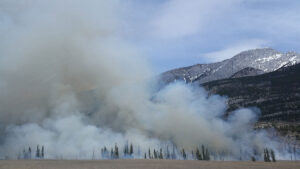The West Coast is currently facing an unprecedented spread of wildfire across the region.
The smoke has drifted over the vast majority of the U.S., and is potentially affecting air quality as far as Washington, D.C. That’s why every employer needs to be aware of the impact wildfire smoke can have on their workers.
Outdoor workers will be the most impacted group, even those who are not directly responding to or fighting the wildfires. Workers in commercial and office buildings can even face risks.
“The smoke from wildfires can affect the air quality and poses a hazard for nearby workers and inside structures without adequate ventilation,” said Doug Parker, chief of the California Division of Occupational Safety and Health.
Is Wildfire Smoke Dangerous?
Plumes of wildfire smoke are filled with tiny particles that stay suspended in the air.
This makes the threat especially insidious, as workers can be breathing in hazardous particles deep into their lungs without realizing it— and can lead to more systematic health effects.
We record air quality with a measurement referred to as PM2.5. This number tells us how many particles sized 2.5 microns and smaller are floating in the air. The higher these levels, the greater the health effects.
In a Wildfire Smoke Guide published by the Environmental Protection Agency, the agency states that 90 percent of particle mass emitted from wildfires is fine particulates.
The Health Effects of Wildfire Smoke Exposure
Most of the research done on the health effects of wildfire smoke inhalation focuses on the short-term acute risk.
Those exposed to high PM2.5 levels will feel the effects pretty immediately, which should be a sign to employers to halt or adapt work to be hazard-free. Itchy eyes, sore throat, and dry cough are the most common signals that particles are irritating the lungs.
Smoke exposure can also exacerbate pre-existing conditions such as asthma and other respiratory illnesses. Some findings show that smoky air may also affect the cardiovascular system.
Effects can persist for weeks and months after the exposure is gone. Not only will those with existing conditions deal with flare-ups, but any exposed person may be more at risk of contracting infectious diseases. A Montana study found that areas that experienced a high volume of wildfire smoke had higher rates of seasonal flu.
Can Smoke Exposure Increase the Risk of COVID-19?
As wildfire smoke and air pollution can make people more susceptible to respiratory infections, the short answer is yes. Exposure to PM2.5 can also impact the body’s ability to fight off infections such as COVID-19.
How to Protect Workers
To protect workers from smoke-related hazards from wildfires, the Hierarchy of Controls is the best option. Especially with the ongoing COVID-19 outbreak, respirators and N95 masks may not be readily available. Use engineering controls when possible, but in most cases, administrative controls may be most effective at reducing exposure.
Effective administrative controls include staggering work shifts, moving work if possible, modifying tasks that require the most exertion and offering more breaks and rest periods in areas with filtered air.
Don’t assume that all indoor air is safe air. The onus is on employers to make sure that air in the workplace is being effectively filtered. Using HEPA filters and setting air conditioning to recirculate can keep air clean.
Most of all, keep an eye on your local PM2.5 levels. Green and yellow categories, or a PM2.5 range of 0-100 indicate that it is a good time to be outside. A range of 100-150 can be dangerous for those with underlying health conditions such as asthma, heart disease, and COPD.
The air quality is unhealthy for everyone if the PM2.5 is above 150, so it’s best practice to halt outdoor activity.
Medical Surveillance Testing
If you require your team to wear respirators for 30 or more days per year, they’ll need physicals, fit testing, and medical clearance. But if wildfire smoke is affecting your area, respiratory testing is a good idea regardless.
That’s when we’re here to help.
Let’s face it, it’s not always easy to coordinate trips to the clinic. And, it’s risky, especially during a pandemic. We make it easier by bringing the entire clinic to your worksite with mobile medical surveillance testing.
We conduct on-site respirator fit tests (including N95 masks), as well as pulmonary function tests and heavy metal lab work, right on your job site. We also keep accurate, easy-to-access medical records for your convenience. You’ll keep your employees at work, and stay ahead of OSHA inspections.
With Worksite Medical, a mobile medical testing unit — we can bring all the resources of a lab to you. Our certified lab technicians can perform both qualitative and quantitative respirator tests to ensure a perfect fit.
Protect your team and your workplace now with Worksite Medical. Not sure what you need? Try our medical testing wizard here.
Give us a call at 1-844-622-8633, or complete the form below to schedule an on-site visit or to get your free quote!




